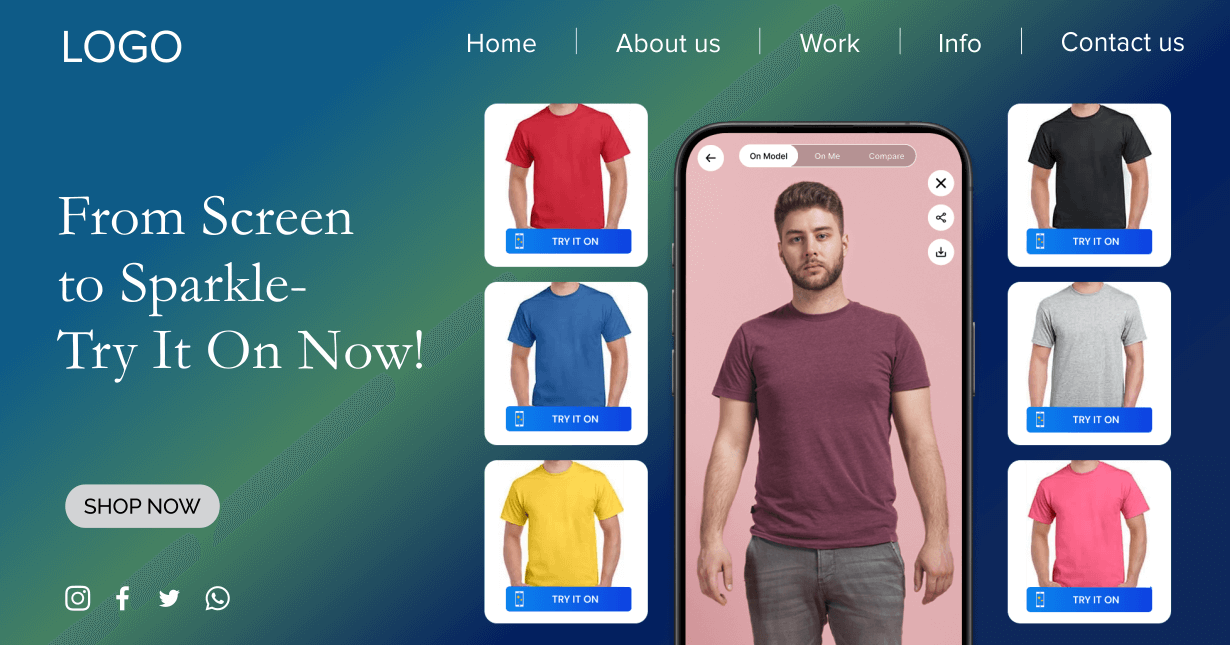There is no doubt that artificial intelligence and augmented reality have reshaped how customers interact with products online. Gone are the days when customers had to second-guess online purchases due to the inability to ‘try before they buy.’
In present times, AI-powered virtual try on technology is reshaping the shopping experience across industries, creating immersive, personalized, and frictionless experiences that convert browsers into buyers.
As we delve deeper into this transformation, we will discover why virtual try Ons are not just a trend, but the cornerstone of the next gen retail evolution.

What is Virtual Try On Technology?
Virtual Try On Technology (VTO) utilizes augmented reality (AR) and artificial intelligence (AI) to allow customers to digitally try on products in real-time. Whether it’s clothes, shoes, glasses, or makeup, virtual try tools replicate the in-store experience by overlaying digital images onto a live or static image of the user.
This innovative technology allows shoppers to make informed purchasing decisions along with increasing customer satisfaction levels and minimizing returns—two core pillars of the future of the retail industry.
How Virtual Try On Technology Works?
VTO systems combine computer vision, AR, machine learning, and real-time image processing to simulate how a product would look on a user. It can be simplified as:
- Camera Activation: Users give permission to enable the device camera to upload or click a picture of the user.
- Object Detection:The system uses AI and shows a placeholder of the relevant body part where they need to place that part.
- AR Overlay:A 2D or 3D model of the product (e.g., earring, watch, etc.) is overlaid on the image.
- Real-Time Interaction:Users can move, rotate, and view the product from different angles, often with the option to customize colors and sizes.
All of this takes place instantly (within seconds) to make the user experience seamless and immersive.
Know the top companies that provide virtual showroom solutions.
Industries Leading the Virtual Try On Revolution
VTO technology isn’t new, many industries have been using it for years and have leveraged its potential to improve their conversion and retention rate. Here are some examples:
Clothes Try-On (Apparel)
The fashion industry was among the first to embrace virtual try-on technology to tackle online shopping’s biggest hurdle—fit uncertainty. VTO permits users to try on outfits virtually by simulating how fabrics drape on different body shapes. AI customizes the experience using the shopper’s size and preferences, improving accuracy.
Example: Zara introduced a VTO feature in selected stores and online which lets users see how clothes fit on digital avatars that mirror their body shapes. Similarly, ASOS launched a “See My Fit” tool, using AR to show how dresses and outfits appear on models of varying sizes and ethnicities.
Shoes Try-On (Footwear)
Shoe fitting is notoriously difficult online, but virtual try Ons for shoes have changed that. This advancement uses AR to superimpose shoes on a user’s feet in real-time, offering a true-to-scale 3D view from multiple angles.
Understand the difference between traditional and digital business cards.
Example: Nike launched the “Nike Fit” app, which scans the user’s foot using a smartphone camera and recommends the perfect size across different shoe models. Wanna Kicks, an AR app by Wannaby, lets users try on sneakers virtually with stunning realism, and it’s already integrated into several major brand platforms.
Glasses Try On (Eyewear)
Eyewear shopping online can be tricky and frustrating without trying on different frames. VTO for glasses uses facial recognition to align frames accurately on the user’s face, allowing rotation, angle change, and lens customization.
Example: Warby Parker set a benchmark with its AR-based try-on feature in its mobile app. Customers can see exactly how different eyeglasses will look on their faces before buying. LensKart, offers similar technology, allowing users to try hundreds of different glasses virtually before making a purchase decision.
Watches Try-On (Watches and Wrist Accessories)
Luxury and lifestyle watch brands now offer virtual try options to let shoppers see how a timepiece looks and fits on their wrist. These tools display not just aesthetics but also show size comparison—crucial when choosing a watch online.
Example: TAG Heuer implemented AR features on its website that allow users to see how watches look on their wrists using just a smartphone camera. WatchBox, a leading luxury watch retailer, offers AR-try-ons through its app to elevate the digital shopping experience for high-end clients.
Jewelry Try-On (Jewelry Items)
Buying jewelry online often lacks the emotional connection and visual assurance of in-store purchases. VTO bridges this gap by helping customers visualize how pieces look in various lighting and angles, improving confidence in their choices.
Example: Kendra Scott introduced an AR-based try-on feature for earrings, letting users see how distinctive styles look on their ears. Tanishq, a premium jewelry brand, also launched a virtual try-on experience that lets users test out necklaces, earrings, and even bridal sets online.
Understand 3D development and its applications, benefits, and scope for your business.
Makeup Try-On (Cosmetics)
One of the most advanced uses of virtual try on technology is in the beauty industry. AI adjusts for different skin tones, lighting conditions, and facial expressions to simulate a realistic application of makeup products like lipsticks, foundations, eyeshadow, mascara, and more.
Example: L’Oréal revolutionized digital beauty with its ModiFace platform, which uses AI and AR to let users try on makeup virtually through apps and websites. Sephora’s Virtual Artist feature allows shoppers to test thousands of makeup products virtually, both on their website and in-store tablets.
Benefits of AI in Virtual Try On

Increased Conversion Rates
Shoppers are more likely to complete purchases when they are confident in their selection. By enabling users to visualize products accurately, virtual try on technology significantly boosts conversion rates, especially in fashion, eyewear, and cosmetics.
Reduced Return Rates
Many online returns are due to unmet expectations. VTO minimizes this by providing a realistic preview, helping customers choose the right product for the first time. Retailers have seen return rate reductions of up to 40%, highlighting their role in shaping the future of the retail industry.
Learn how digital business cards are revolutionizing the BSFI sector.


Enhanced Customer Engagement and Loyalty
The interactive nature of virtual try Ons boosts dwell time and engagement. Features like sharing try-on photos on social media or receiving AI-powered style suggestions improve the user experience and build lasting brand loyalty.
Competitive Advantage
Retailers using next gen retail solutions like VTO differentiate themselves in saturated markets. It demonstrates innovation and customer-centricity—two traits that consumers increasingly value.


Access to Valuable Data & Insights
Every interaction with a virtual try system generates data—preferences, engagement metrics, and behavioral patterns. AI analyzes this data to refine product offerings, forecast trends, and personalize marketing strategies.
Cost Savings on Physical Inventory
With VTO, retailers can highlight entire collections without manufacturing each product up front. This reduces warehousing costs and allows for more flexible product experimentation—a big plus in today’s agile retail environment.

Impact on Customer Buying Behavior
The influence of virtual try on technology on buyer behavior is profound. Shoppers are more confident, less impulsive, and more likely to explore new categories. The ability to try before buying fosters a sense of control and satisfaction, encouraging repeat purchases and greater brand interaction. It also taps into the digital-first mindset of Gen Z and millennials, making it integral to the next gen retail experience.
Challenges and Limitations of Virtual Try on Technology
Although it offers several advantages, there are some challenges, these are:
- Device Compatibility:Not every user has access to high-resolution cameras or AR-enabled devices.
- Accuracy Issues:Poor lighting or camera angles can distort product visuals, impacting realism.
- Privacy Concerns: Capturing and analyzing facial or body data raises data security and ethical issues.
- Implementation Cost:Developing AI-powered VTO systems is expensive and resource-intensive, especially for small businesses.
Guide for visual commerce: Things you should know.
Therefore, overcoming these challenges requires a commitment to innovation, ethical AI use, and customer education—crucial steps for any brand looking to thrive in the future of the retail industry.
Conclusion
As we look ahead, it’s clear that AI-powered virtual try on technology is more than a trend—it’s a disruptive force transforming retail from the ground up. By merging the tactile appeal of in-store shopping with the convenience of eCommerce, VTO is improving user experience, reducing returns, and more.
Whether you are a fashion brand, a beauty retailer, or an eyewear company, embracing virtual try Ons isn’t just a competitive advantage—it’s essential for surviving and thriving in the next gen retail ecosystem. The future of shopping is here, and it’s virtual, intelligent, and personal.
If you have any requirements for the same or want to learn more about it, then contact us at sales@iphygital.ai
